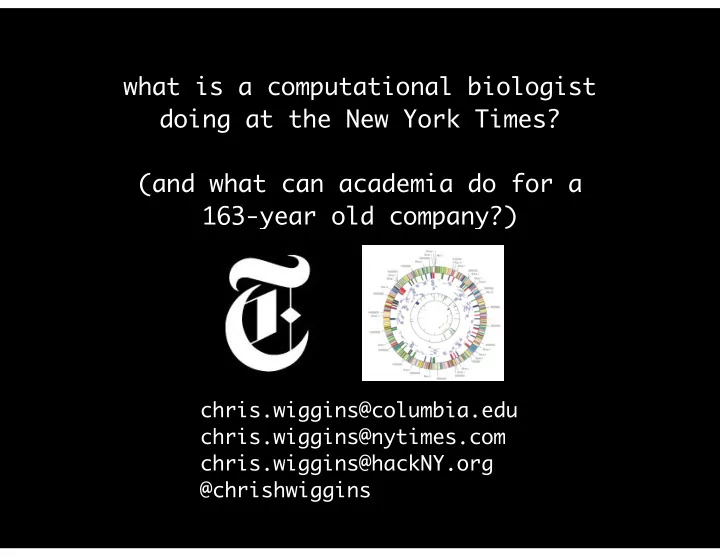

what is a computational biologist doing at the New York Times? � (and what can academia do for a 163-year old company?) chris.wiggins@columbia.edu chris.wiggins@nytimes.com chris.wiggins@hackNY.org @chrishwiggins
context/background
context/background (before ‘the talk’)
biology: 1892 vs. 1995 biology changed for good.
genetics: 1837 vs. 2012 from “segments” to algorithms
genetics: 1837 vs. 2012 from intuition to prediction
data science: web scale
example: 163 yr old
bit.ly/nyt-interactive-2013
R+D: nytlabs.com
developer.nytimes.com: 2008
example: millions of views per hour
insert figure here from “segments” to algorithms
insert figure here from intuition to prediction
data science: the web
data science: the web is your “online presence”
data science: the web is a microscope
data science: the web is an experimental tool
data science: the web is an optimization tool
</header>
</header> i.e., <body>
common requirements in data science:
common requirements in data science: 1. practices 2. skills 3. culture
common requirements in data science: 1. practices 2. skills 3. culture
common requirements in data science: 1. practices 2. skills 3. culture
data science: practice
data science: practice - reframe domain questions as machine learning tasks
data science: practice - better wrong than "nice"
data science: practice - be relevant �
data science: practice - be relevant �
data science: practice - be relevant �
data science: practice - hypotheses are not data jeopardy �
data science: practice - befriend experimentalists �
data science: practice - befriend experimentalists �
data science: practice - befriend experimentalists �
data science: skills
data science: skills - find quantifiables �
data science: skills - find quantifiables (choose carefully) �
data science: skills - straw man first �
data science: skills - straw man first �
data science: skills - small wins before feature engineering �
data science: skills - data engineering before data science �
data science: culture
data science: culture - be communicative �
data science: culture - be communicative (promote rhetorical literacy)
data science: culture - be communicative (promote rhetorical literacy) - related: strive to build models which are both predictive and interpretable
data science: culture - be skeptical (promote critical literacy)
data science: culture - be empowering �
data science: culture - be transparent �
data science: culture - promote literacy: functional critical rhetorical � (cf. Selber, Multiliteracies for a Digital Age. 2004)
data science: culture - promote literacies: 1. functional 2. critical 3. rhetorical � (cf. Selber, Multiliteracies for a Digital Age. 2004)
data science: culture - promote literacies: 1. functional 2. critical 3. rhetorical � (cf. Selber, Multiliteracies for a Digital Age. 2004)
data science: culture - promote literacies: 1. functional 2. critical 3. rhetorical � (cf. Selber, Multiliteracies for a Digital Age. 2004)
data science: culture - promote literacies: 1. functional 2. critical 3. rhetorical � (cf. Selber, Multiliteracies for a Digital Age. 2004)
</body> i.e., <footer>
summary:
summary: pay attention to: 1. practices 2. skills 3. culture
practices: 1. reframe questions as ML 2. better wrong than "nice" 3. be relevant 4. aim for hypothesis vs data jeapordy 5. befriend experimentalists
skills: 1. find quantifiables 2. straw man first 3. small wins before feature engineering 4. data engineering before data science �
culture: 1. be communicative 2. be skeptical 3. be empowering 4. be transparent 5. promote literacies
find out more! 1. postdoc/student opportunities: chris.wiggins@columbia.edu � 2. always hiring: chris.wiggins@nytimes.com � 3. let’s talk: - @chrishwiggins - gist.github.com/chrishwiggins/
what is a computational biologist doing at the New York Times? � (and what can academia do for a 163-year old company?) chris.wiggins@columbia.edu chris.wiggins@nytimes.com chris.wiggins@hackNY.org @chrishwiggins
Recommend
More recommend